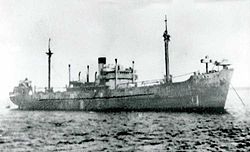Kronenfels (ship, 1945)
|
Standard ship type Hansa-B
|
||||||||||||||||||||||
|
||||||||||||||||||||||
|
||||||||||||||||||||||
|
||||||||||||||||||||||
|
||||||||||||||||||||||
The Kronenfels of the German Steamship Company "Hansa" (DDG "Hansa"), completed in 1945, was a standard cargo ship of the Hansa-B type .
According to a plan from mid-1944, the Bremer Reederei was to receive 16 newbuildings as part of the Hansa program, four of which were type B ships. In fact, only the medium-sized Kronenfels was completed for the DDG "Hansa" by the end of the war .
The second Kronenfels came into service on February 20, 1945 as the only type B standard cargo ship of the shipping company and was confiscated by the British at the end of the war in Copenhagen in 1945. As Empire Roden , the ship remained under the British flag until 1948.
In 1948 it became Florida Sword under the American flag, in 1956 Cheyenne , then St. Nicholas under the Liberian flag. On August 8, 1958, the former Kronenfels was stranded on a reef with a load of wheat on a trip from the USA to Colombia near Jamaica. Rescue attempts were unsuccessful.
History of the ship
During the Second World War , the DDG "Hansa" was one of the eight shipping companies that founded the "Schiffahrt Treuhand GmbH" on June 23, 1942 with the aim of developing the contractual and financial framework for a program for the series production of standard cargo ship types that would prevent the war losses of the Germans Shipowners should compensate.
As part of the Hansa building program , three types of ships (Hansa type A, type B, type C) were developed, which were primarily designed for the accessible navigation areas of the North and Baltic Seas. For each type, a so-called "front-end shipyard" was determined, according to whose design the series structures were to be built. This was the Bremer Vulkan for the middle "Type B". The ships were to be built in German and shipyards in German-occupied states. In July 1944, four “Type B” ships were planned for the Bremen shipping company, only two DDG “Hansa” ships under construction at Helsingörs Jernskibs og Maskinbyggeri in Helsingör / Denmark.
The later Kronenfels was started in June 1943 at the Danish shipyard and was launched on December 21 as Halsnæs for the Danish shipowners' association. The still unfinished ship was renamed Helgenæs in November 1944 . After an attempt at sabotage, the Navy confiscated the ship and had it towed to the German shipyard in Hamburg for prefabrication . The ship then delivered this to DDG "Hansa" on February 20, 1945 as Kronenfels .
As a medium-sized ship "Hansa B", it was measured with 2843 GRT and had a deadweight capacity of 5460 tdw. She was 109.5 m long, 15.51 m wide and had a draft of up to 6.33 m. The 4-cylinder double-compound steam engine of the type LES 9 was supplied by AG Weser and produced 1800 PSi with a Bauer-Wach exhaust steam turbine , acted on a screw and gave the ship a speed of 11 knots (kn). The loading gear consisted of a 65 t and 30 t boom as well as twelve 5 t booms on the two masts and four boom / fan posts side by side in front of and behind the bridge house.
A sister ship started in Helsingör in March 1943 was launched on January 29, 1945 as Huberfels for DDG "Hansa". However, it was delivered to North German Lloyd on April 17, 1945 as Langeoog . The two further planned type B ships were not built.
Mission history of the Kronenfels
The Kronenfels was used by the DDG "Hansa" on behalf of the Navy for transport tasks. On April 18, 1945, the ship from Hela, which was used to clear the German eastern territories, arrived in Copenhagen and also had 159 survivors of the sinking of the Goya on board. At the end of the war, the ship was confiscated by the British in the Danish capital. In the meantime transferred to Great Britain, the Kronenfels was renamed Empire Roden in July 1945 . The ship was assigned to the United States as loot and in late 1948 was transferred to the Sword Line in New York, which renamed it Florida Sword . In 1949 the ship was converted to run on oil.
In 1956 the ship was resold to Monrovia . Initially renamed Cheyenne , she was then installed as St. Nicholas . On the voyage with a cargo of wheat from Galveston to Colombia, the St. Nicholas ran on August 8, 1958, about 135 nautical miles south-southwest of Kingston (Jamaica) on a reef. After unsuccessful rescue attempts, the wreck of the former Kronenfels was abandoned in September 1958.
DDG "Hansa" -ships of the type "Hansa B"
| Surname | Shipyard | GRT tdw |
Launched in service |
further fate |
|
Kronenfels (2) |
Elsinore building no. 280 |
2843 5460 |
December 21, 1943 February 20, 1945 |
1945 Great Britain: Empire Roden , 1948 USA: Florida Sword , 1956 Liberia: Cheyenne , St. Nicholas , accrued August 8, 1958; |
|
Huberfels (2) |
Elsinore building no. 279 |
2776 5280 |
01.09.1945 17.04.1945 |
in service as Langeoog of the NDL, 1945: Great Britain, then Soviet Union: Mechanik Afanasiev , Serpukhov , 1975 demolished; |
Web links
- The second Kronenfels on ddghansa
- The Huberfels , then Langeoog
literature
- Hans Georg Prager: DDG Hansa - from liner service to special shipping , Koehlers Verlagsgesellschaft, Herford 1976, ISBN = 3-7822-0105-1
